Lego New York

From J.R. Schmidt, a rendering of New York City in Lego. Prints are available. Be sure to check out his other work as well…cool stuff.



This site is made possible by member support. ❤️
Big thanks to Arcustech for hosting the site and offering amazing tech support.
When you buy through links on kottke.org, I may earn an affiliate commission. Thanks for supporting the site!
kottke.org. home of fine hypertext products since 1998.

From J.R. Schmidt, a rendering of New York City in Lego. Prints are available. Be sure to check out his other work as well…cool stuff.
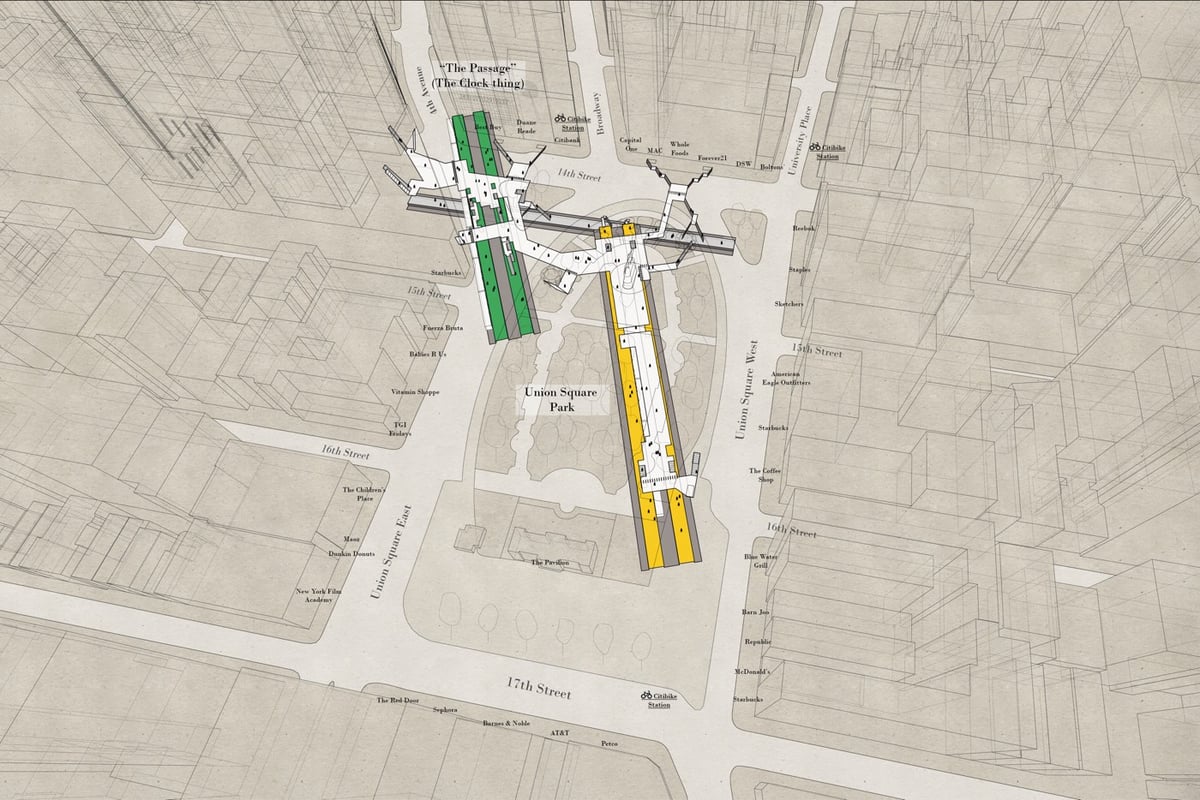
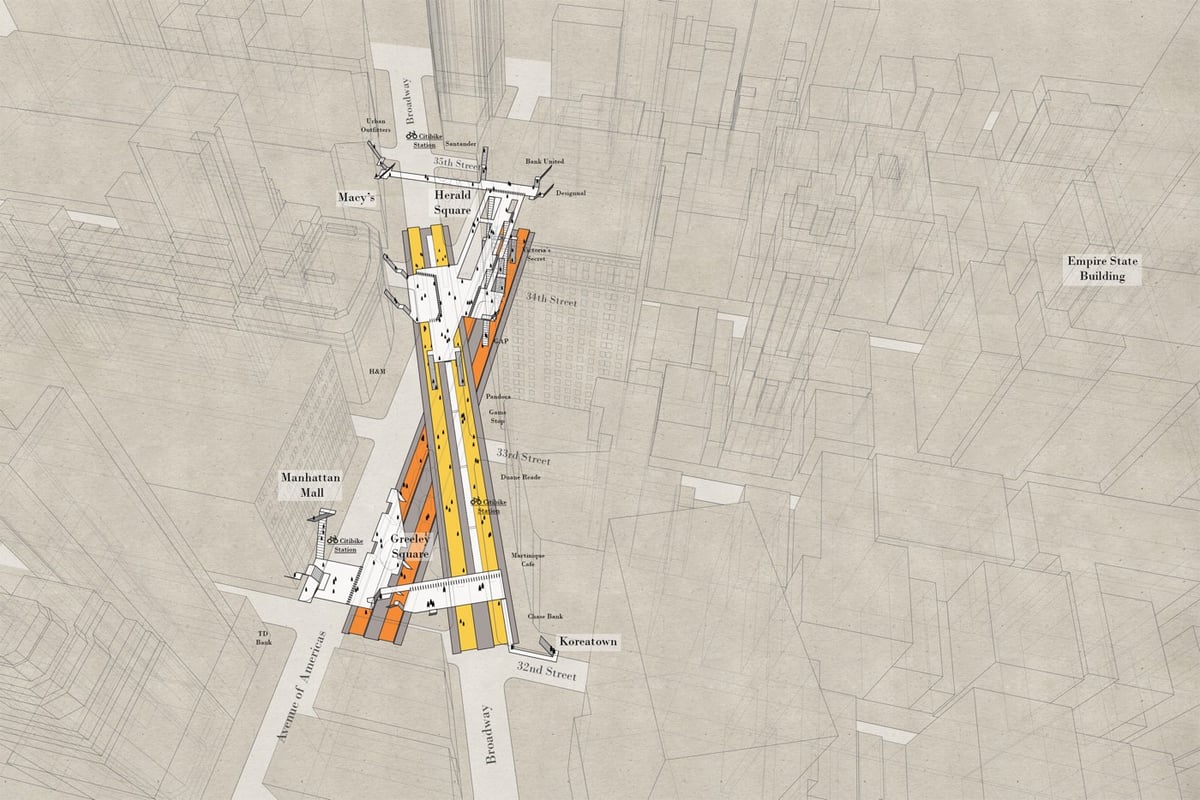
The subway and the street level of NYC are two very different worlds and even long-term residents have a difficult time understanding how they fit together. Architect Candy Chan has drawn a series of x-ray maps of NYC subway stations that show their layouts and orientation compared to the geography of the streets above. (Tip: you can zoom the maps for more detail.)
The series is an extension of her station layouts series. Prints are available in Chan’s shop.
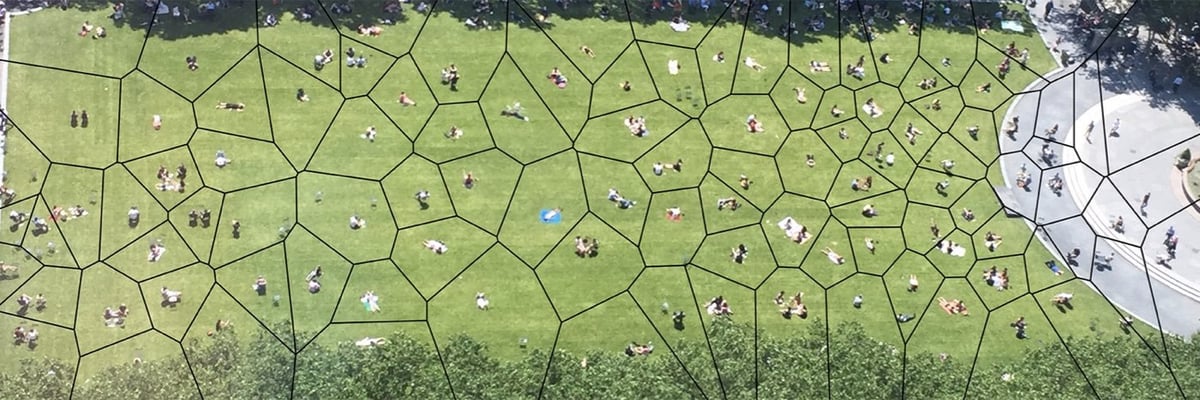
Starting with an overhead shot of people sitting out in the sun in NYC’s Bryant Park, Rod Bogart laid what’s called a Voronoi diagram on top of it. A Voronoi diagram is a way of mapping out areas where any point in a given area is closer to a seed point than it is to any other seed point. You can think of it as a sphere of influence…and in this case, you can see how the park-goers have organized themselves into having their own personal space. As Bogart says:
It’s fascinating to see the real world optimization problem of wanting to get a nice large patch of grass.
I often think about Voronoi diagrams when I get into an elevator.
I stand alone in the elevator, right in the middle, equidistant from the four walls. Before the doors close, a woman enters. Unconsciously, I move over to make room for her. We stand side by side with equal amounts of space between the two of us and between each of us and the walls of the elevator. On the 12th floor, a man gets on and the woman and I slide slightly to the side and to the back, maximizing the space that each of us occupies in the elevator. At the 14th floor, another man gets on. The man in front steps to the back center and the woman and I move slightly toward the front, forming a diamond shape that again maximizes each person’s distance from the elevator walls and the people next to them.
See also “the human ellipse”.
Sergio Rojo has cut together scenes from more than 70 movies that are set in NYC, including Manhattan, Ghost, Tootsie, Taxi Driver, Breakfast at Tiffany’s, Birdman, and The Devil Wears Prada. Familiar locations like Times Square, Central Park, the Brooklyn & Manhattan Bridges, the subway, the Empire State Building, the NYPL, and the Statue of Liberty are all amply represented. (via gothamist)
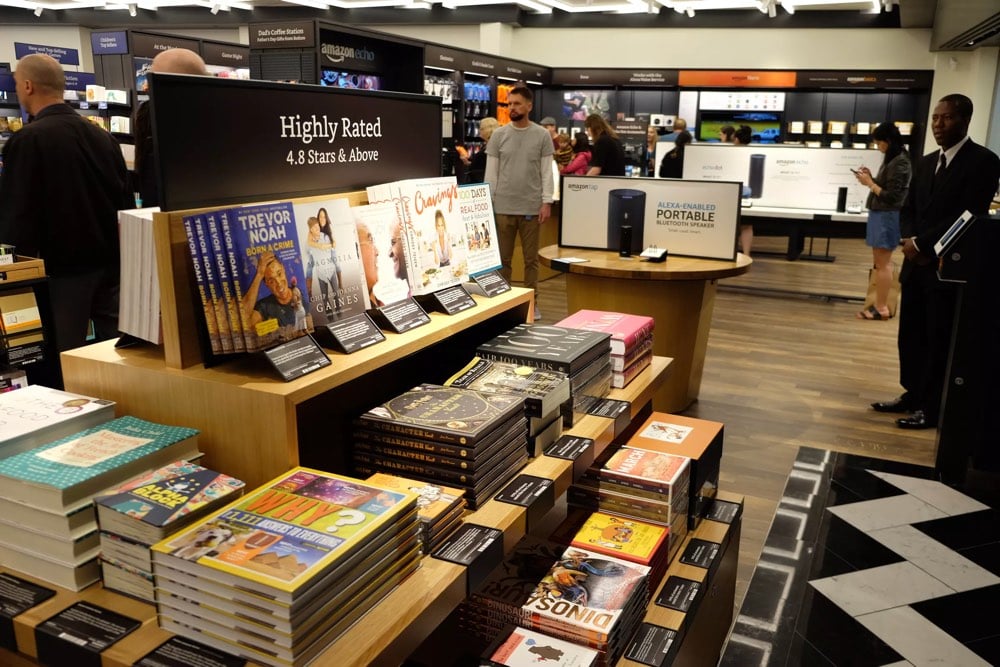
Over at Recode, Dan Frommer has a look inside Amazon’s first NYC bookstore, opening Thursday in the mall in the Time Warner Center. I haven’t visited any of Amazon’s stores yet (they’ve got several around the country), but what I find interesting from the photos is how up-front they are about the shopping experience being data driven. There are signs for books rated “4.8 Stars & Above”, a shelf of “Books Kindle Readers Finish in 3 Days or Less”, a section of “If You Like [this book], You’ll Love [these other books]”, and each book’s shelf label lists the star rating and number of reviews on Amazon.com. Another sign near the checkout reads “Over 7950 Goodreads members like this quote from Cassandra Clare’s Clockwork Prince: ‘We live and breathe words.’”
Other bookstores have books arranged according to best-seller lists, store-specific best-sellers, and staff recommendations, but I’ve never seen any store layout so extensively informed by data and where they tell you so much about why you’re seeing each item. Grocery store item placement is very data driven, but they don’t tell you why you’re seeing a display of Coke at the end of the aisle or why the produce is typically right at the entrance. It’ll be interesting to see if Amazon’s approach works or if people will be turned off by shopping inside a product database, a dehumanizing feeling Frommer hints at with “a collection of books that feels blandly standard” when compared to human curated selections at smaller bookstores.
P.S. So weird that there’s no prices on items…you have to scan them with a store scanner or a phone app. Overall, the store feels less oriented towards its book-buying customers and more towards driving Prime memberships, Amazon app downloads, and Kindle & Echo sales (which might be Amazon’s objective).
Update: Jia Tolentino on Amazon’s stores.
The store’s biggest shortcoming, though, is that it is so clearly not intended for people who read regularly. I normally walk into a bookstore and shop the way a person might shop for clothes: I know what I like, what generally works for me, what new styles I might be ready to try. It was a strange feeling, on Thursday, to do laps around a bookstore without feeling a single unexpected thrill. There were no wild cards, no deep cuts, no oddballs — just books that were already best-sellers, pieces of clothing I knew wouldn’t fit me or that I already owned.
Tolentino also notes that the fiction section in the NYC store contains fewer than 200 different titles.
Last week (approx. May 7-14), I stopped using social media for an entire week. I logged out of all the sites and deleted the apps from my phone. I didn’t so much as peek at Instagram, which is, with Twitter and old-school Flickr, probably my favorite online service of all time. I used Twitter as minimally as I could, for work only.1 I didn’t check in anywhere on Swarm. No Facebook. As much as I could, I didn’t use my phone. I left it at home when I went to the grocery store. I didn’t play any games on it. I left it across the room when I went to bed and when I worked.
Many people have given up social media and written about it — the digital equivalent of the “Why I’m Leaving New York” essay — but since I didn’t write about leaving New York, I’m going to do this instead.
I used to be very good about using my phone and social media appropriately. More than a decade of working on kottke.org taught me how to not be online when I wasn’t working (for the most part). I tried super hard not to use my phone at all around my kids and if I was out with friends, my phone stayed in my pocket.2
Almost a year ago, after 13+ years in the city, I moved from lower Manhattan3 to rural Vermont. It’s beautiful here. I live in a house in the country surrounded by horse pasture and there’s great skiing in the winter. The nearest town is only five minutes away by car; it has a two-screen movie theater, a handful of restaurants (none of which are typically open after 10pm), two grocery stores, but nowhere to get a proper donut, sushi, or bowl of ramen. (The nearest ramen is an hour’s drive away.) While I was writing this post yesterday afternoon, the power in my house went out and didn’t come back on for three hours, forcing a delay in publication. It’s been difficult to meet people. Folks here are nice, but they mostly remind me of the people in the small town I grew up in (aka why I moved to the city in the first place). I work from home at a desk in my bedroom and some days, the only beings I’ll talk to are Siri, my landlord’s horses, and some days, my kids and their mom.
Social media, mostly through my phone, has been an important way for me to stay connected with friends and goings on in the wider world. But lately I’d noticed an obsessiveness, an addiction really, that I didn’t like once I became fully aware of it. When I wasn’t working, I was on my phone, refreshing Instagram, Twitter, and Facebook repeatedly in an endless series, like a little old lady at Caesar’s Palace working several slot machines at the same time. And I couldn’t stop it — my phone was in my hand even when I was trying to concentrate on my kids, watching a movie, or reading a book. So, I quit for a week to see what would happen. It’s not a super-long time period, but here’s what I noticed:
- Once I’d set my mind to it, it was pretty easy to go cold turkey. Perhaps my Twitter usage and keeping up with the news for kottke.org acted as a nicotine patch, but I don’t think so. Instagram was the toughest to stay away from, but I didn’t crack once.
- As the week went on, it was more and more evident that it wasn’t so much social media as the phone that was the problem. Even now, a few days after the conclusion of my experiment, I’m leaving my phone at home when I go out or across the room when I’m doing something. I’m going to try hard to keep this up.
- Buuuut, when you have kids, there is no such thing as giving up your phone. There’s always the potential call from their school or their mom or their doctor or another parent regarding a playdate or or or. I spend enough time online at my computer for work that I could mostly do without my phone, but with kids, that’s not really an option.
- Not a single person noticed that I had stopped using social media. (Not enough to tell me anyway.) Perhaps if it had been two weeks? For me, this reinforced that social media is actually not a good way to “stay connected with friends”. Social media aggregates interactions between loved ones so that you get industrialized communication rather than personal connection. No one really notices if a particular person goes missing because they’re just one interchangeable node in a network.
- My no-social week, for a variety of reasons, was probably the shittiest week I’d had in more than a year. Total emotional mess. Being off social media didn’t make it any better, but I doubt it made it worse. Overall, it was probably a good thing I wasn’t subjecting my friends and followers to self-subtweets and emo Instagram Stories…I was already scoring enough own goals without social media’s help.
- So, what did I do instead? I wish I could say that I had loads of extra free time that I used to learn Spanish, clean my house, catch up with old friends, cook delicious meals, and finish a couple work projects. Perhaps if shittiest week ever hadn’t been happening, I would have done some of that. Still, I did end up going to bed early every night, read a couple books, and had more time for work and dealing with kid drama.
After the week was up, I greedily checked in on Instagram and Facebook to see what I had missed. Nothing much, of course. Since then, I’ve been checking them a bit less. When I am on, I’ve been faving and commenting more in an attempt to be a little more active in connecting. I unfollowed some accounts I realized I didn’t care that much about and followed others I’ve been curious to check out. Swarm I check a lot less, about once a day — there was a lot of FOMO going on when I saw friends checked in at cool places in NYC or on vacations in Europe. And I’m only checking in when I go someplace novel, just to keep a log of where I’ve been…that’s always fun to look back on.
Mostly, I’ve resolved to use my phone less. Being on my phone was my fidget spinner…this thing that I would do when there was nothing else to do or that I would use to delay going to bed or delay getting out of bed in the morning. Going forward, I’m going to be more mindful about its use. If nothing else, my hands and thumbs might start feeling better.
Yeah, I did not stop using Twitter. Ideally I would have, but Twitter is a huge source of information for this here website and I couldn’t afford to give it up without ditching work for a week, which I did not want to do because I wanted to maintain my normal schedule. But I didn’t look at Twitter on my phone, didn’t reply to or fave any tweets, muted some non-news/link accounts I follow, and limited my usage to “business hours”.↩
Still one of my favorite tweets is from Scott Simpson: “My new standard of cool: when I’m hanging out with you, I never see your phone ever ever ever.”↩
Haha, you’re getting a mini leaving NYC essay anyway. Suckers!↩

For years, a white woman named Lisa Davis was paying the price (sometimes literally) for tickets issued to other women named Lisa Davis living in NYC.
Finally, the DMV told me that I wasn’t the victim of identity theft; there was simply another Lisa S Davis with the same birthday in New York City. Our records were crossed. When cops run a license, they don’t check the person’s address, signature, or social security numbers. They check the name and the birthday, and both the other Lisa S Davis’s and mine were the same. We were, in the eyes of the law, one person, caught in a perfect storm of DMV and NYPD idiocy.
In fighting all of these improperly filed tickets, Davis learned that most of them issued for bullshit “broken windows” misdemeanors in predominately minority neighborhoods.
It was then that it became clear to me: the reason for the tickets wasn’t that these Lisa Davises were petty criminals. The reason was likely that they lived in highly policed areas where even the smallest infractions are ticketed, the sites of “Broken Windows” policing. The reason, I thought, was that they weren’t white.
That could have been the “proof” I offered to the judge. Brownsville’s population is less than 1% white. It almost couldn’t have been me. My neighborhood, though fairly diverse (and cheap) when I moved there in the early 90s, is now 76% white. I have never heard of anyone getting tickets in my neighborhood for any of the infractions committed by the Lisa Davises in neighborhoods of color.
I felt there was only one thing to do. I had to find the Lisa Davises, to untangle myself from them, to talk to them about being Lisa Davises, and to see if they agreed with my supposition: that the real “crime” they had committed was being non-white.
See also Pro Publica’s report published today, Minority Neighborhoods Pay Higher Car Insurance Premiums Than White Areas With the Same Risk.
Citizen Jane: The Battle for the City is a documentary films about Jane Jacobs and her legendary battle against Robert Moses for the soul of New York City.
People have to insist on government trying things their way.
The film will be available in theaters and on-demand on April 21.
I’m a bit more than halfway through the audiobook of The Power Broker and Robert Moses is approaching the height of his influence. The power that Moses possessed in NYC almost cannot be overstated — I can’t think of any other single person who affected the “look and feel” of the city more than he did. I have heard the story many times, but I can’t wait to get the part with Jacobs, to hear in Caro’s words how this infinitely powerful man lost his grip on the city because of this remarkable woman and a group of concerned citizens. (via @daveg)
Update: Astoundingly, Jacobs is not in The Power Broker. Her chapter was cut for length. (thx, alec)
In 2012, Francois De La Taille posted a video of himself racing a Paris Metro train from one station to the next, on foot. He exited the train, dashed out of the station, sprinted down the street (after pausing for a bus crossing the road), ran into the next station (after falling on the stairs), and hopped back onto the same train he’d just gotten off of.
Two years later, James Heptonstall did the same thing on the London Tube and, after a slow start, it went viral. Soon, people from all over the world were racing their hometown subway trains: Taiwan, Stockholm, Hong Kong, etc. If you’re wondering whether such a thing would be possible in NYC, the answer is yes, even if you pick the wrong door to start with:
(via @ftrain)

From the New Yorker, Rebecca Solnit on how the world’s places are mostly named after men.
A horde of dead men with live identities haunt New York City and almost every city in the Western world. Their names are on the streets, buildings, parks, squares, colleges, businesses, and banks, and their figures are on the monuments. For example, at Fifty-ninth and Grand Army Plaza, right by the Pulitzer Fountain (for the newspaper magnate Joseph Pulitzer), is a pair of golden figures: General William Tecumseh Sherman on horseback and a woman leading him, who appears to be Victory and also a nameless no one in par-ticular. She is someone else’s victory.
The biggest statue in the city is a woman, who welcomes everyone and is no one: the Statue of Liberty, with that poem by Emma Lazarus at her feet, the one that few remember calls her “Mother of Exiles.” Statues of women are not uncommon, but they’re allegories and nobodies, mothers and muses and props but not Presidents.
For her book Nonstop Metropolis: A New York City Atlas, Solnit and her co-author Joshua Jelly-Schapiro commissioned Molly Roy to make a subway map of NYC that uses only the names of the city’s prominent women for the station names.
It’s a map that reflects the remarkable history of charismatic women who have shaped New York City from the beginning, such as the seventeenth-century Quaker preacher Hannah Feake Bowne, who is routinely written out of history — even the home in Flushing where she held meetings is often called the John Bowne house. Three of the four female Supreme Court justices have come from the city, and quite a bit of the history of American feminism has unfolded here, from Victoria Woodhull to Shirley Chisholm to the Guerrilla Girls.
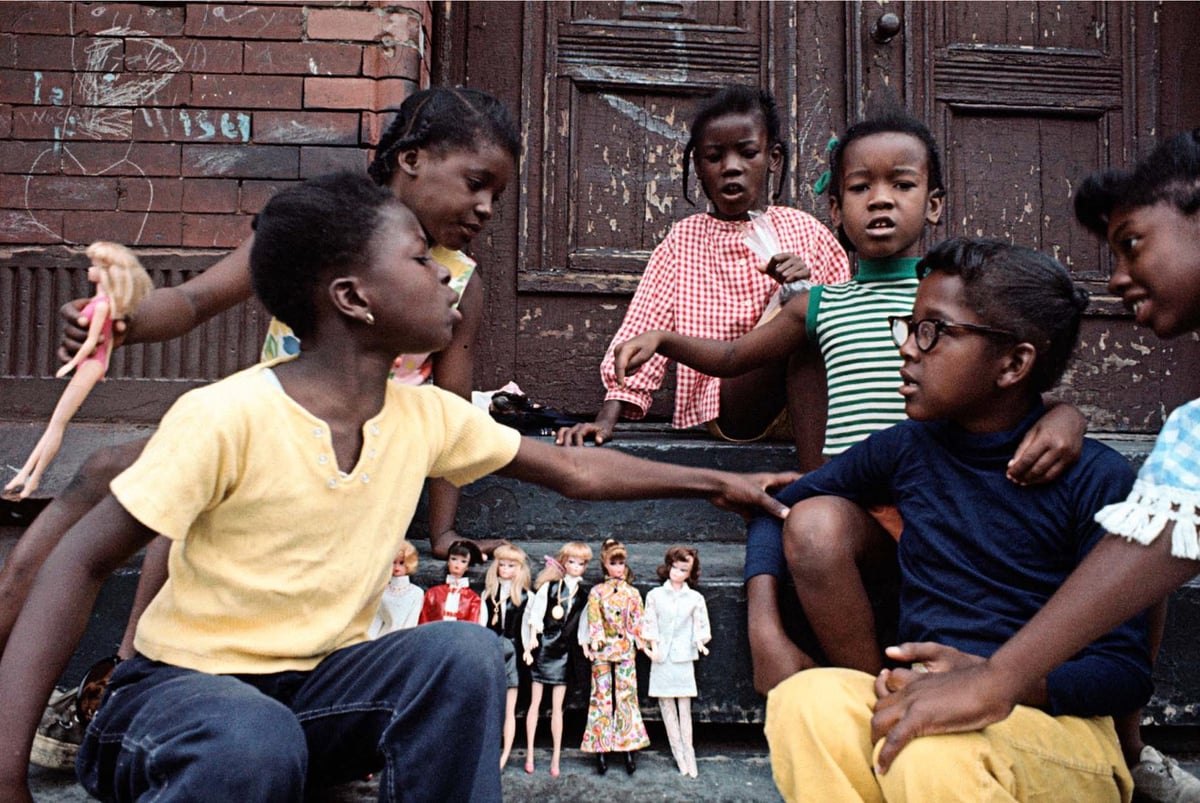
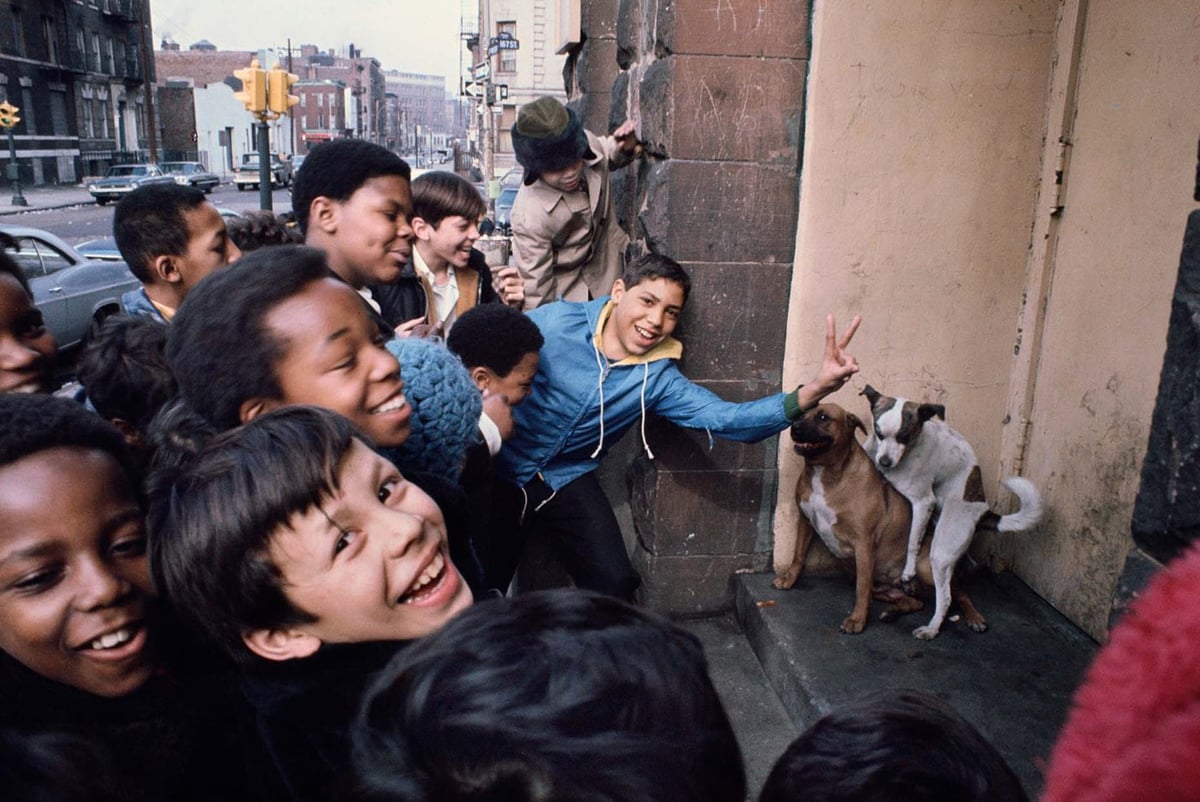
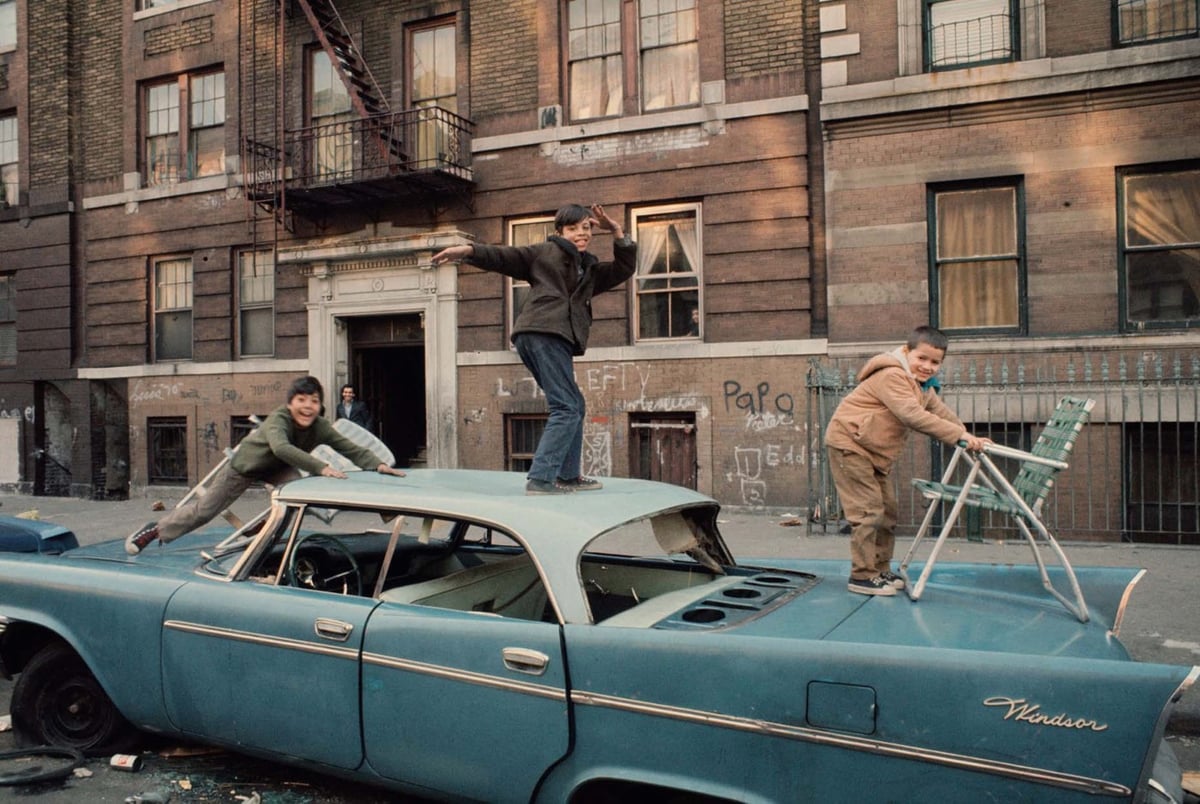
In the early 1970s, Camilo José Vergara trained his camera on scenes of everyday street life in New York City. His photographs captured kids playing on the street, subway cars before graffiti, sections of the Bronx that look bombed out, and the construction of the World Trade Center in progress.
See also his Tracking Time project, specific locations around the US photographed repeatedly over periods of up to 40 years. Vergara was awarded a MacArthur Genius Grant in 2002 for this work.
The Green Angels is a group of pot dealers that was started by a former fashion model named Honey (not her real name). Many of the dealers and dispatchers are also former models…or at least possess enough good looks and easy charm to talk their way out of trouble with NYPD officers.
Honey is clear-eyed about the nature of her operation: “I tell the girls, it’s not a club; it’s a drug ring.” The whole business is run via text messages between her, the dispatchers in her headquarters, the runners who do the deliveries, and the customers. “I have carpal tunnel in my thumb from all the texting,” Honey says. Dispatchers get 10 percent of each sale; the runners get 20 percent, which averages out to $300 or $400 a day. Several of them, according to Honey, “are paying off their NYU student loans.”
Just like any other business, there are tricks of the trade and protocols to follow:
One of the Angels suggests using a tote bag instead of a backpack to carry the box. She generally uses a WNYC tote bag, which is given out to donors to the public-radio station. The other day, an old lady gave her a high five after seeing her tote. “I thought, If you only knew what I have in this bag,” she says.
Honey tells the girls to get a work phone from MetroPCS, which costs $100. When buying it, they should pay in cash and have a name in mind to put down on the form, in case the police check. “I like to use the names of girls who were my enemies growing up,” Honey says.
The business is organized and disciplined, which I suspect it needs to be if you don’t want to get tossed in jail:
The Green Angels average around 150 orders a day, which is about a fourth of what the busiest services handle. When a customer texts, it goes to one of the cell phones on the table in the living room. There’s a hierarchy: The phones with the pink covers are the lowest; they contain the numbers of the flakes, cheapskates, or people who live in Bed-Stuy. The purple phones contain the good, solid customers. Blue is for the VIPs. There are over a thousand customers on Honey’s master list.
To place an order, a customer is supposed to text “Can we hang out?” and a runner is sent to his apartment. No calling, no other codes or requests. Delivery is guaranteed within an hour and a half. If the customer isn’t home, he gets a strike. Three strikes and he’s 86’d. If he yells at the runner, he’s 86’d immediately.
The Angels work only by referral. The customers should refer people they really know and trust, not strangers, and no one they’ve met in a bar. If you refer someone who becomes a problem, Charley says, you lose your membership.
Really interesting throughout.

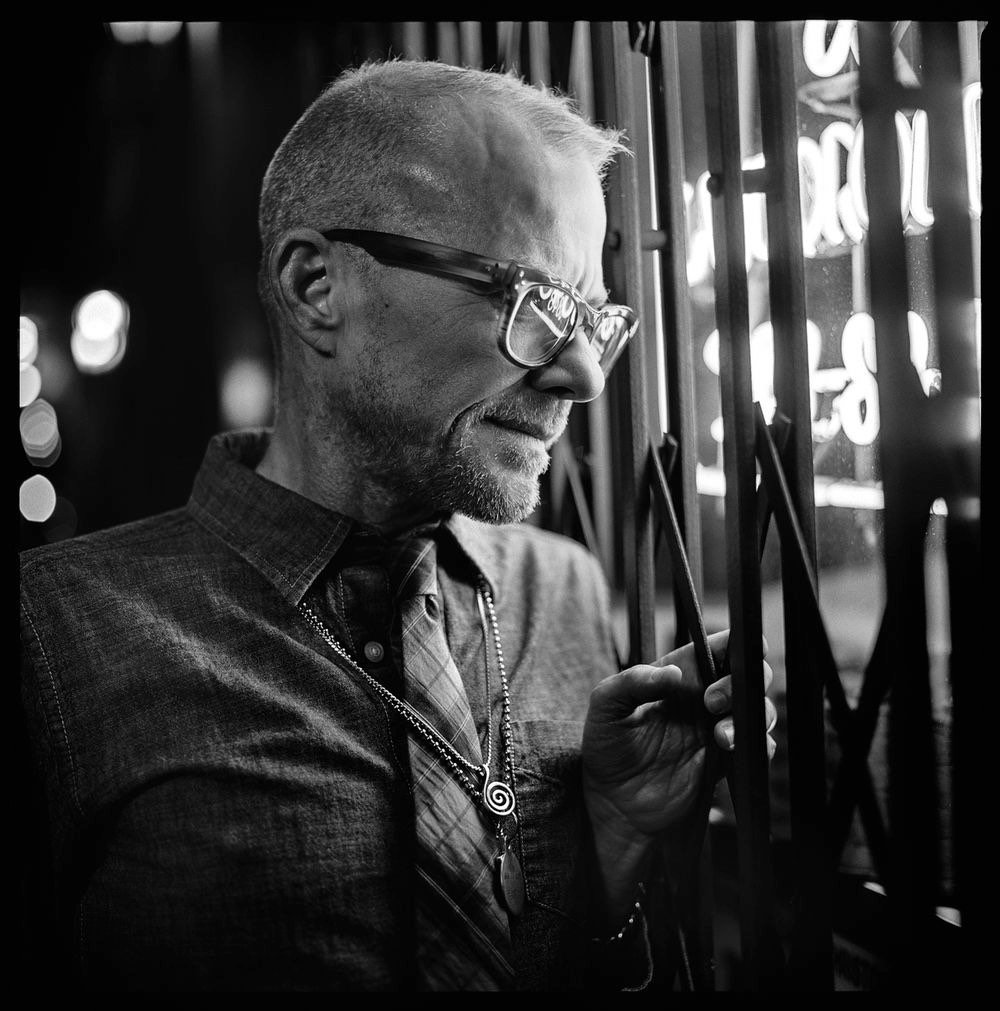

Over a number of recent summers, well-known portrait photographer Mark Seliger has been documenting the transgender community that gathers on Christopher St in the West Village. Since Seliger’s website is slow and bloated, I’d recommend checking out coverage of the photos on The Advocate, The New Yorker, American Photo, and PDN. I lived on Christopher Street for several years1 and definitely recognize a couple of people in Seliger’s photos.
It was in the Village, on Christopher Street and the nearby piers, where many trans and queer people first shared space with others like them. For generations, these places provided mirrors for those who rarely saw reflections of themselves. On Christopher Street, there were multitudes of potential selves: transgender, transsexual, non-binary, genderqueer, femme, butch, cross-dresser, drag king or queen, and other gender identities and sexual orientations that challenge social norms.
Seliger has collected the photos into a book, On Christopher Street: Transgender Stories and the photos will be on display at 231 Projects in Chelsea until early January.
What an amazing and challenging place to live. While the rest of Manhattan (and the West Village) was either gentrified or gentrifying quickly, on Christopher St, you could still find aspects of “old New York” some long-time residents are so nostalgic for. When I lived there (roughly 2009-2014), it was still very much a place where LGBTQ+ people (especially those of color) could come and be their authentic selves with other members of their community, an opportunity denied them in their neighborhoods in Queens or Jersey City. But there was also crime: people openly selling drugs on the corner, robberies, open prostitution, anti-gay violence, and every single weekend from mid-spring to mid-fall, there was property damage up and down the street from visitors absolutely trashing the neighborhood. In response to the crime, the NYPD basically set up a command center on the street with mobile patrol towers and massive lights. Some summer Saturday nights felt like a war zone.↩

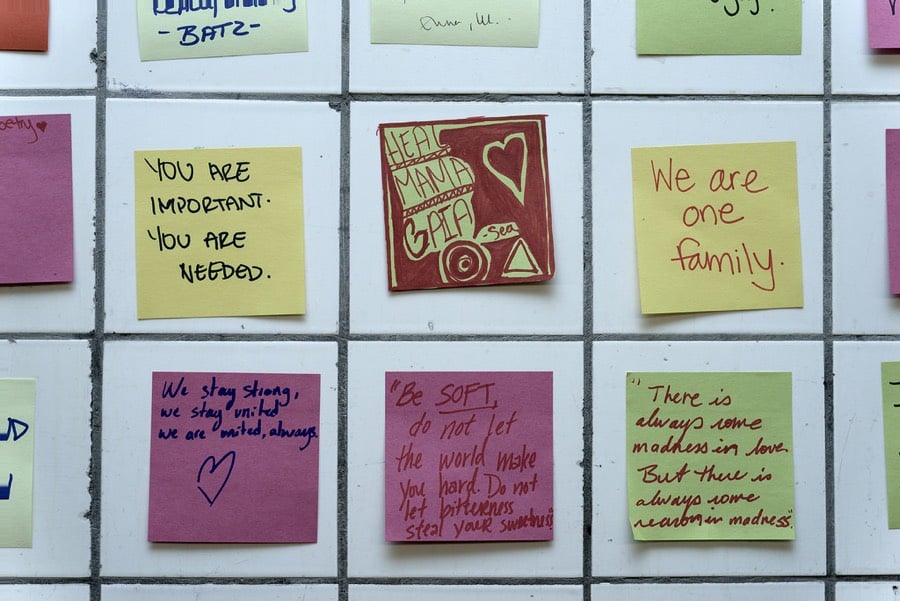
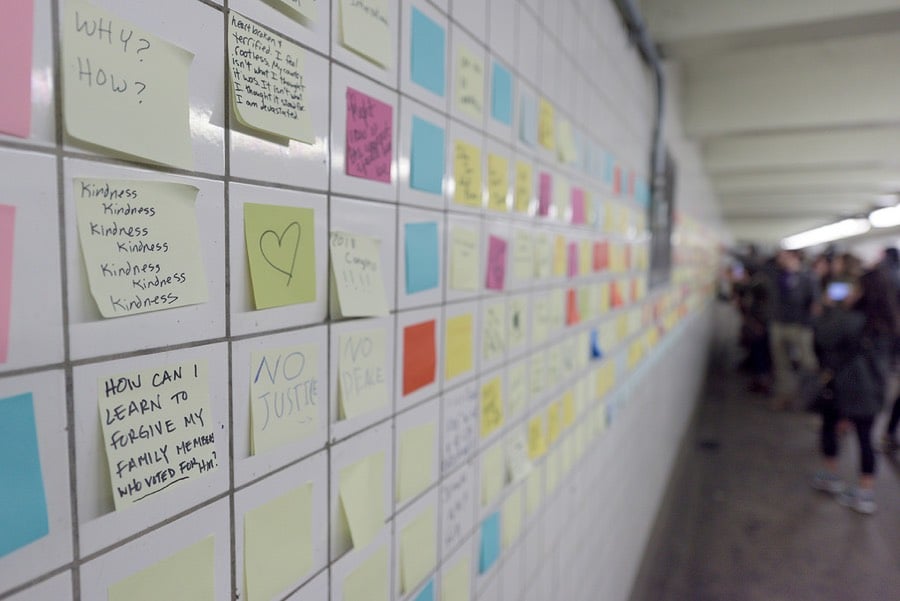
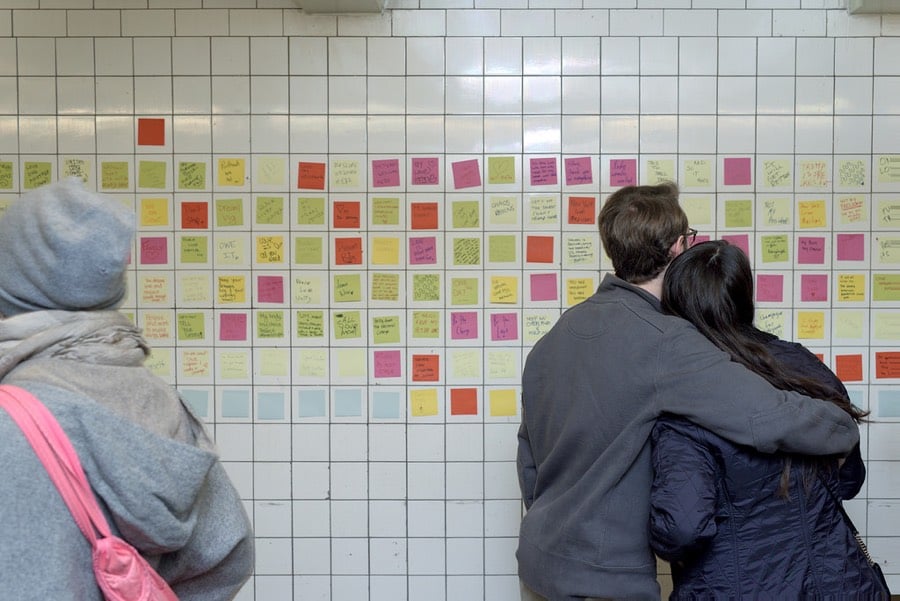
In the wake of the election, Matthew Chavez, who goes by “Levee” and is the instigator of Subway Therapy, encouraged New Yorkers to share their post-election grief on Post-it Notes stuck to the wall of the tunnel between the 6th and 7th Ave subway stations on 14th St. Joe Holmes visited the tunnel and took photos of people interacting with the wall. (All photos above by Joe Holmes.)
In a short essay from Literary Hub titled New York is a Book Conservatives Should Read, Rebecca Solnit writes an open letter to Donald Trump urging him to take some lessons from the city in which he lives. Solnit argues that Trump’s wealth has insulated him from experiencing one of the true pleasures of American cities like New York: energetic and meaningful diversity.
You treat Muslims like dangerous outsiders but you seem ignorant of the fact that the town you claim to live in has about 285 mosques, and somewhere between 400,00 and 800,000 Muslims, according to New York’s wonderful religious scholar Tony Carnes. That means one out of ten or one out of twenty New Yorkers are practitioners of the Islamic faith. A handful of Muslims, including the Orlando mass murderer, who was born in Queens, have done bad things, but when you recognize how many Muslims there are, you can stop demonizing millions for the acts of a few.
NYC is only one-third white and is home to hundreds of thousands of Muslims and Jews and millions of blacks, Latinos, and Asians.
Speaking of African-Americans: have you ever been to Harlem or the Bronx? You keep talking about black people like you’ve never met any or visited any black neighborhoods. Seriously, during that last debate you said, “Our inner cities are a disaster. You get shot walking to the store. They have no education. They have no jobs. I will do more for African-Americans and Latinos than she can ever do in ten lifetimes. All she’s done is talk to the African-Americans and to the Latinos.” Dude, seriously? Did you get this sense of things from watching TV-in 1975?
Solnit wrote the piece after compiling her most recent book, Nonstop Metropolis: A New York City Atlas.
Bringing together the insights of dozens of experts — from linguists to music historians, ethnographers, urbanists, and environmental journalists — amplified by cartographers, artists, and photographers, it explores all five boroughs of New York City and parts of nearby New Jersey. We are invited to travel through Manhattan’s playgrounds, from polyglot Queens to many-faceted Brooklyn, and from the resilient Bronx to the mystical kung fu hip-hop mecca of Staten Island.
This NY Times piece on the political inclinations of rural areas vs cities is an interesting companion to Solnit’s letter.
“There is something really kind of strange and interesting about the connection between peoples’ preferences — what they view as the good life, where they want to live — and their partisanship,” said Jonathan Rodden, a political scientist at Stanford. His precinct-level maps of presidential election results show deep blue in the densest, central parts of metropolitan areas, where you’d find the Main Streets, city halls, row homes and apartment buildings. The farther you travel from there, the redder the precincts become. And this is true whether you look around New York City or Terre Haute, Ind.
In the late 1980s, five black and Latino teenagers were wrongly convicted of raping a woman jogging in Central Park. The Central Park Five is a documentary film directed by Ken Burns, Sarah Burns, and David McMahon which tells the story from the perspective of the those five teens. I’ve seen the film, it’s excellent, and it’s currently available to watch for free on the PBS website.
The five men and this terrific miscarriage of justice are back in the news because of Donald Trump. In 1989, just a few weeks after the attack in Central Park, Trump took out a full-page ad in the Daily News denouncing the crime and the teens in which he calls for bringing back the death penalty.
Perhaps he thought it gave him gravitas, that spring, to weigh in on the character of the teen-agers in the park: “How can our great society tolerate the continued brutalization of its citizens by crazed misfits? Criminals must be told that their CIVIL LIBERTIES END WHEN AN ATTACK ON OUR SAFETY BEGINS!”
When NYC finally settled with the wrongly convicted men in 2014, Trump denounced the settlement, joining a police detective in calling it “the heist of the century.” And just before Trump’s crowing about sexual assault of women broke over the weekend, Trump reaffirmed that despite all evidence to the contrary, he believes that the five men are still guilty.
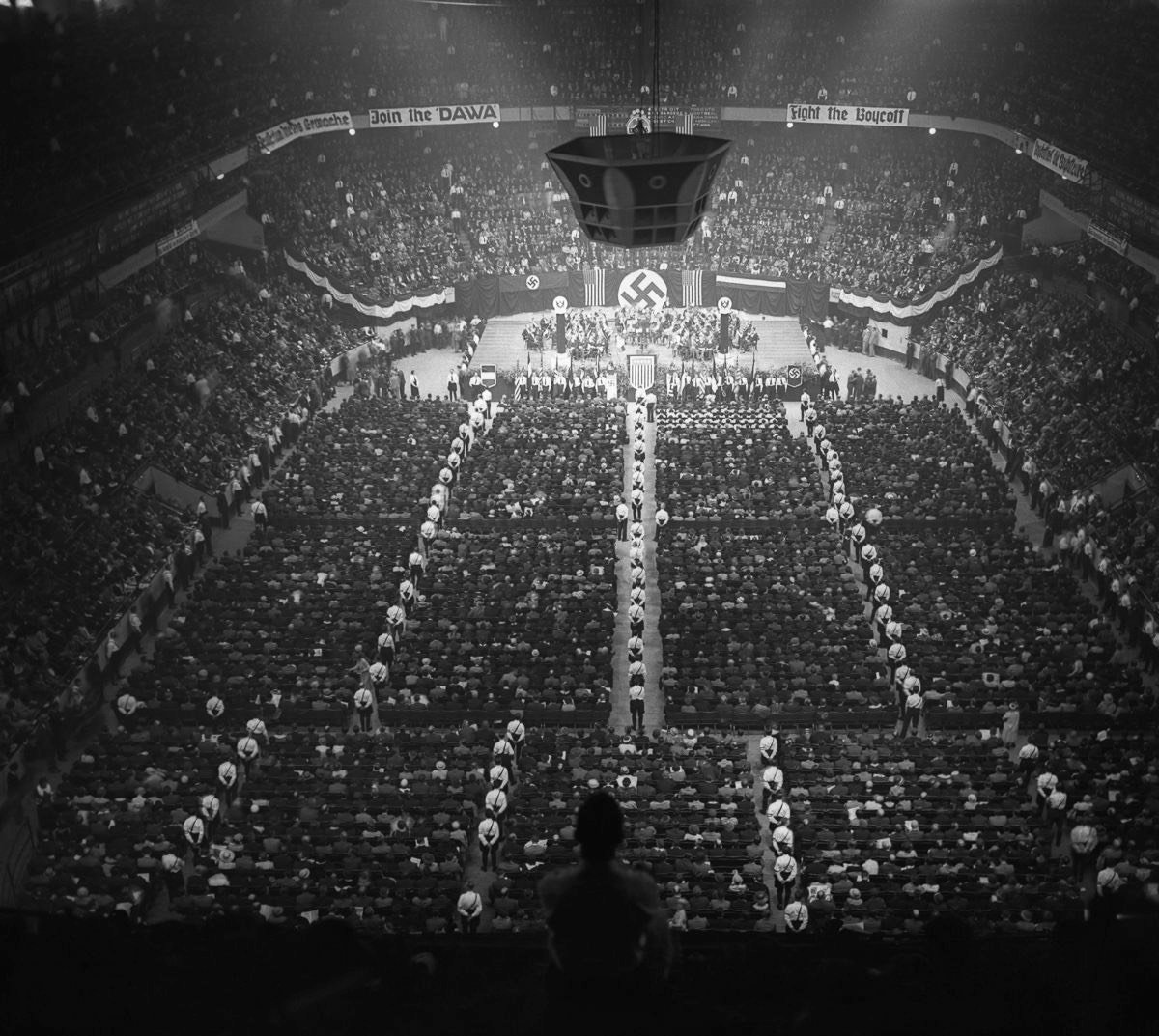
In the 1930s, almost a decade before the nation’s young men would be shipped overseas to combat the foul stench of Hitler wafting across Europe, official and unofficial rallies for the Nazi party were held in Madison Square Garden.
Shortly after Adolf Hitler’s appointment as Chancellor of Germany in January 1933, the Nazis consolidated control over the country. Looking to cultivate power beyond the borders of Germany, Deputy Führer Rudolf Hess charged German-American immigrant Heinz Spanknobel with forming a strong Nazi organization in the United States.
Combining two small extant groups, Spanknobel formed Friends of New Germany in July 1933. Counting both German nationals and Americans of German descent among its membership, the Friends loudly advocated for the Nazi cause, storming the offices of New York’s largest German-language paper, countering Jewish boycotts of German businesses and holding swastika-strewn rallies in black-and-white uniforms.
A later group, which only disbanded at the end of 1941, were prominently pro-American and featured iconography of George Washington as “the first Fascist”. (I would have gone for “the Founding Fascist”…catchier.)




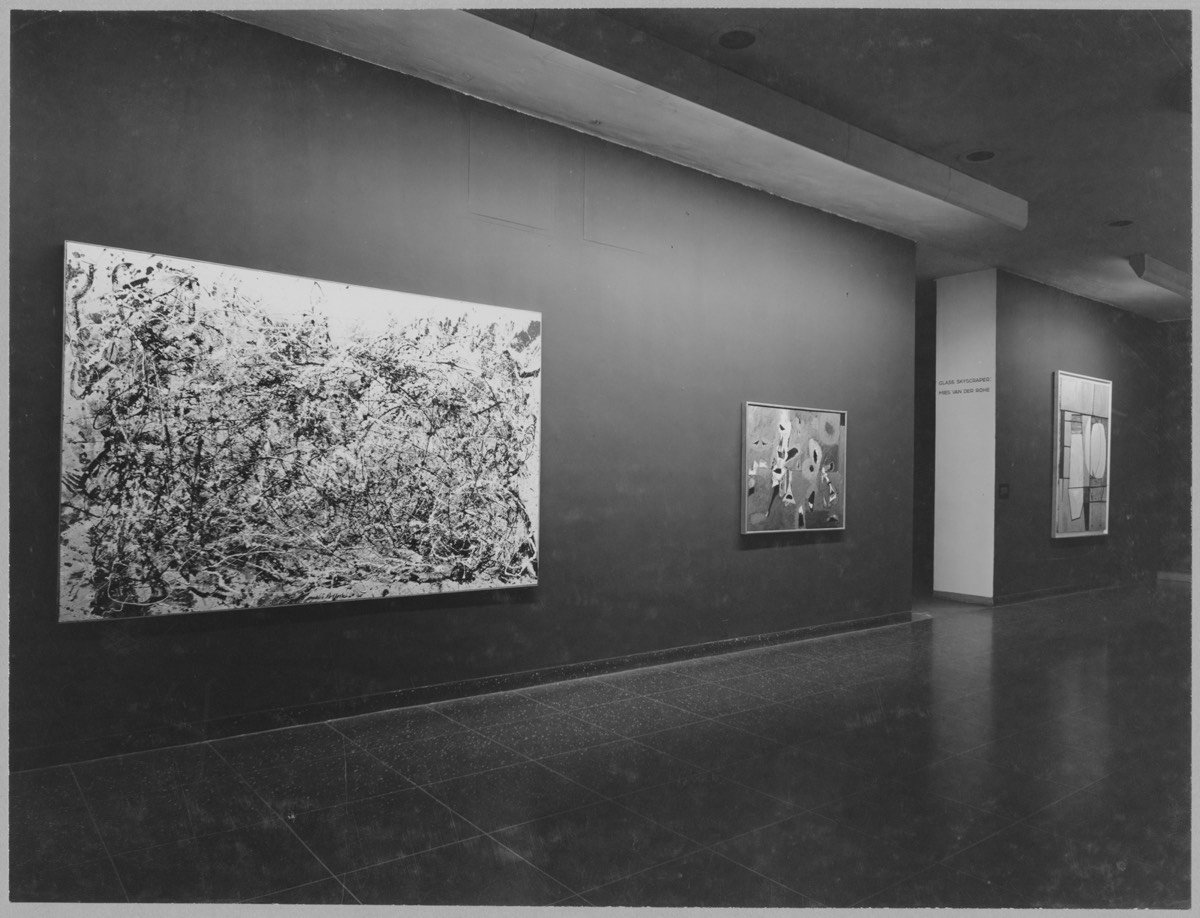
The Museum of Modern Art has started the process of putting online a massive trove of photographs of what the museum’s exhibitions looked like, extending back to their earliest big exhibition in 1929 of works by Cézanne, Gauguin, Seurat, and van Gogh. The NY Times has the story.
The digital archive project will include almost 33,000 exhibition installation photographs, most never previously available online, along with the pages of 800 out-of-print catalogs and more than 1,000 exhibition checklists, documents related to more than 3,500 exhibitions from 1929 through 1989.
Shown above are some notable works of art pictured among the first times they were displayed at the museum…the top one is from that first show in 1929. I happily spent an hour browsing through these exhibitions1 and I haven’t been gripped with this powerful of a desire to travel through time in quite some time. To be able to see that first exhibition…what a thing that would be. In part, I love going to museums for this very reason: standing in the very spot where the artist stood in making their drawing or painting is a very cheap form of time travel.
Suggested technique: search for an artist or artwork you particularly like and sort the results by “opening date, chronological” to see the first time that art or artist was displayed in the museum.↩
Ian Parker wrote about the NY Times’ restaurant critic Pete Wells for the New Yorker this week.
Wells is generally a well-mannered critic, if not an overly respectful one. In his first years on the job, he was sometimes faulted in the food press for being too generous in his appraisals; he had made a point of publishing fewer one-star reviews than his immediate predecessors. “No one likes one-star reviews,” Wells told me, in a conversation at his apartment, which is in a Clinton Hill brownstone. “The restaurants don’t like them, and the readers don’t like them. It’s very tricky to explain why this place is good enough to deserve a review but not quite good enough to get up to the next level.” He added, “I’m looking for places that I can be enthusiastic about. Like a golden retriever, I would like to drop a ball at the feet of the reader every week and say, ‘Here!’”
Parker covers Wells’ most notable reviews — Per Se, Fieri, Senor Frog’s, Momofuku Nishi — as well as the reactions of the restaurants to the reviews.
“I can’t ever read that review again — I’ll get so fucking angry I’ll die,” Chang said. “I made a lot of that food! I tasted it! It was delicious. And… fuck! I believe in the fucking food we make in that restaurant, I believe it to be really delicious, I believe it to be innovative, in a non-masturbatory way.”
I love David Chang. Never change. But back to Wells, I had a conversation last night with a friend who worked in a restaurant that Wells reviewed and he said that Wells is perhaps not physically suited for undercover restaurant dining — “he’s an odd looking dude” was the quote. And I have another friend in the restaurant industry who, after living in Clinton Hill for a few months, told me, “I think Pete Wells is my backyard neighbor.” Several months later: “Yeah, Pete Wells definitely lives behind me.” We joked about Wells talking over the fence in the style of Wilson, the neighbor in Home Improvement whose face is always partially hidden.
Opened in 1995 on St. Marks in the East Village, the @ Cafe was one of the first (and coolest) internet cafes in the US.1 They had a bunch of computers, a T1 line (at $9000/mo!), a hip menu including alcoholic beverages, and no idea what they were doing. They didn’t plan for ventilation for all the hardware, so they cooled the server room with a garbage can full of ice!
And I was glad to hear the CU-SeeMe shout out at the very end of the video. I think about that app every time I hear about something “new” like Facebook Live, Periscope, or Snapchat. Talk about being ahead of its time…CU-SeeMe was video chat that predated the popularity of the web.
At the time, very few people even knew what the “@” symbol was. One article featured in the video described it like so: “that @ is pronounced ‘at’ in case you were curious, and it’s often used in e-mails, the way most hackers and computer freaks communicate with one another”. LOL.↩

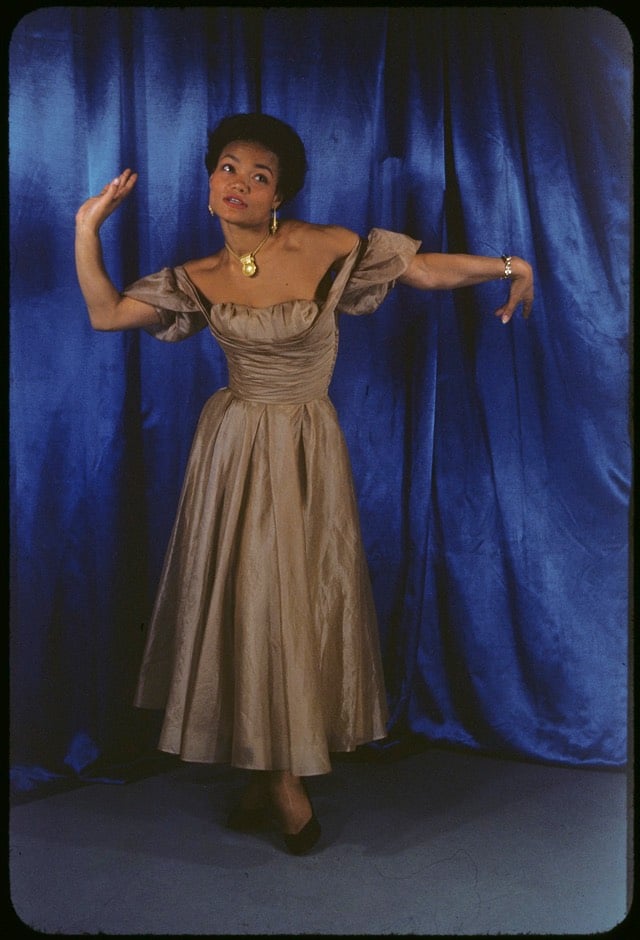

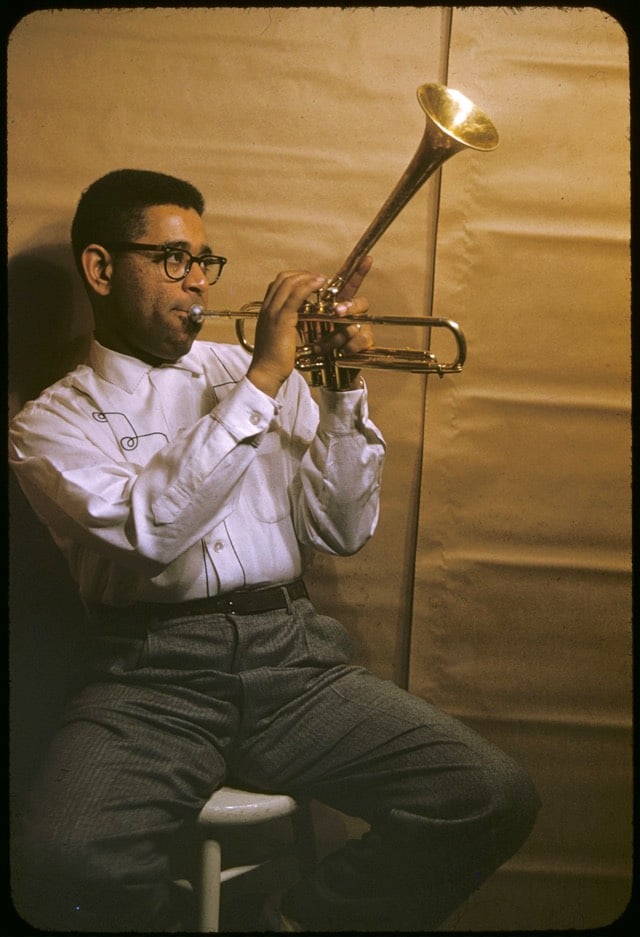

Carl Van Vechten moved to New York in the early 20th century and became “violently interested in Negroes”. As part of that interest, Van Vechten got to know many of the leading black figures in the city and photographed them, first in black & white but later in vibrant Kodachrome. Almost 2000 of his color photos are available at Yale’s Beinecke Library (direct search). Pictured above are Van Vechten’s photos of Ella Fitzgerald, Eartha Kitt, W.E.B. DuBois, Dizzy Gillespie, and a young James Earl Jones. (via the new yorker)
When he was asked to design a new outpost of iconic NYC hot dog joint Papaya King in the East Village, Andrew Bernheimer went around to several other establishments in the city built to serve food quickly — Chipotle, Russ & Daughters, Katz’s, Shake Shack, Gray’s Papaya — and looked at their floor plans and flow of customers through their spaces. Mark Lamster talked to Bernheimer about the survey.
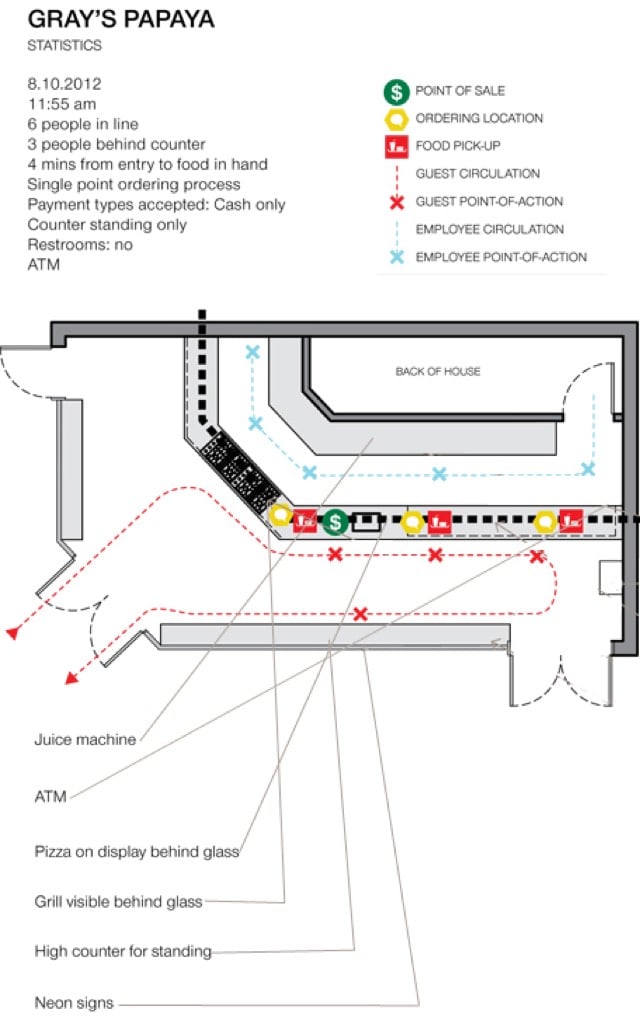

ML: I think at fast food joints we’re conscious that we’re in a very controlled environment, but perhaps don’t realize (because we are in a rush), just how manipulative that space can be. How did you see this playing out in the places you looked at?
AB: It ranged. Artisanal places (like Russ & Daughters) don’t feel manipulative in an insidious way at all (other than showing off some great food and triggering all sorts of synaptic response), while others do (Five Guys and their peanuts, a pretty nasty and obvious trigger to go order soda or spend money on WATER). We didn’t just look at fast food joints, but also icons of New York (R&D, Katz’s) that do try to serve people quickly but I don’t think qualify as “fast food joints.” In these cases the manipulation is either entirely subliminal and beyond recognition, or it has been rendered unnecessary because a place has become iconic, the domain of the “regular.”
Speaking as a customer, places like Katz’s and Russ & Daughters always felt like a total mess to me. Katz’s in particular is the worst: the whole thing with the tickets, paying on the way out, the complete lack of a single line, separate ordering locations for different types of food, etc.
That Gray’s Papaya that used to be on the corner of 8th St and 6th Ave, however, was fantastic. It had the huge benefit of being situated on the corner, but when you walked in, there was the food being cooked right in front of you. It was obvious where the line was and what direction it was moving. And after getting your food, you could exit immediately out the “back” door or circle back against the line to find a counter spot to quickly eat your meal.
On a recent episode of the Serious Eats podcast Special Sauce, Ed Levine talks to Danny Meyer about the origins of the Shake Shack.
Did Meyer have any idea that that hot dog cart would eventually become the massive sensation it is today? Not at all. It was a happy accident, born of his love of burgers, Chicago hot dogs, and the custard that’s still served at Ted Drewes in his native St. Louis.
Martin Pedersen recently reread Jane Jacobs’ The Death and Life of Great American Cities and came away with ten lessons.
3. Jacobs was remarkably prescient on gentrification.
She didn’t invent the term or even use it. But she observed (and I don’t know how, since most cities were in decline at the time) that lively diverse neighborhoods are always at risk for becoming victims of their own success, because newcomers invariably alter the characteristics that made these neighborhoods appealing to them in the first place. Today this seems obvious and self-evident, but that’s largely because of Jane Jacobs.
Yeah, it’s time for a reread…it’s been more than 12 years for me. (via @michaelbierut)
entry for Robert Moses game design contest is done! https://t.co/j75hsCrjV6 — a quick gameplay video: pic.twitter.com/ZIE3C6Kd6M
— Jason Wright (@jsnwr) July 30, 2016
Whoa, this is the coolest! Jason Wright’s Brand New Subway allows players to alter the NYC subway system as they see fit. You can start with existing maps and the choices you make affect ridership and the price of a Metrocard.
Players can choose to start from scratch or one of several NYC subway maps (including present-day, maps dating back to the early 1900s, or maps from the future). They can build new stations and lines to expand the system to new areas, or tear it down and redesign the whole thing. The game intends to evoke an imaginative spirit, to empower people to envision transportation according to their needs and desires, and to arouse the fun of tinkering with maps.
This project is an entry in The Power Broker Game Design Competition, the goal of which is to adapt Robert Caro’s The Power Broker into a playable experience. Wright explains how his game hits the mark:
Bottom-up vs. top-down design. Moses was infamous for his top-down approach to urban planning. He held “the public” as a concept in high regard while simultaneously showing contempt for the individuals who made up that public, in the form of arrogance, spitefulness, and an utter lack of concern for the millions displaced for his expressways and parks. Later on in his career, as the span of his projects increased, Moses would make monumentally important decisions about the fate of a neighborhood without once setting foot there. He was known for building 13 bridges and hundreds of miles of parkways despite never driving a car.
Although Brand New Subway might appeal to someone who enjoyed SimCity but who has never set foot in New York City, it’s targeted primarily at those who actually ride the subway and who might feel invested in what they design. In that regard, it inverts Moses’ paradigm by encouraging players to improve on transportation in their own neighborhoods and in ways to which they have a personal connection.
I reeeeeeally didn’t want to spend the rest of my day playing with this, but that super express train from Manhattan to JFK isn’t going to build itself! (via @byroncheng)
Until their first show at Madison Square Garden in NYC last week, Radiohead hadn’t played Let Down off of OK Computer in concert since 2006. I was lucky enough to be in attendance and some collective shit was lost over this, I tell you what. They’ve since played it at all three of their subsequent shows. (They’ve also played Creep twice in the past week, which is also rare.)
Here’s the full set list from that night, which is mainly just for me in 28 years when this is the last remaining page on the internet with this info.
Burn the Witch
Daydreaming
Decks Dark
Desert Island Disk
Ful Stop
Lotus Flower
The National Anthem
15 Step
No Surprises
Tinker Tailor Soldier Sailor Rich Man Poor Man Beggar Man Thief
Separator
Planet Telex
The Numbers
2 + 2 = 5
Everything in Its Right Place
Myxomatosis
Idioteque
Encore:
Let Down
Present Tense
Paranoid Android
Nude
Bodysnatchers
Encore 2:
Bloom
Street Spirit (Fade Out)
Update: Here’s a video from when they played it in 2006 in Wolverhampton:
(via @jamsandwich)
Chef and Momofuku founder David Chang spends a lot of time thinking about food and he’s arrived at what he calls the Unified Theory of Deliciousness.
My first breakthrough on this idea was with salt. It’s the most basic ingredient, but it can also be hellishly complex. A chef can go crazy figuring out how much salt to add to a dish. But I believe there is an objectively correct amount of salt, and it is rooted in a counterintuitive idea. Normally we think of a balanced dish as being neither too salty nor undersalted. I think that’s wrong. When a dish is perfectly seasoned, it will taste simultaneously like it has too much salt and too little salt. It is fully committed to being both at the same time.
I’m not sure his observations are exactly unified, but they are interesting and also why I enjoy eating at his restaurants so much. A meal I had at Ssam Bar shortly after they switched away from the initial Korean burritos menu is in my top 5 meals of all time and a pair of dishes at Ko (both somehow simultaneously familiar and new) are among the most delicious things I’ve ever eaten.
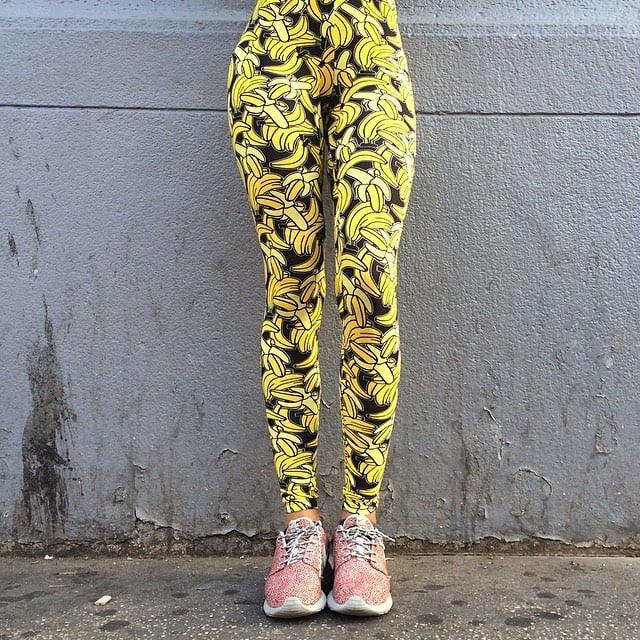
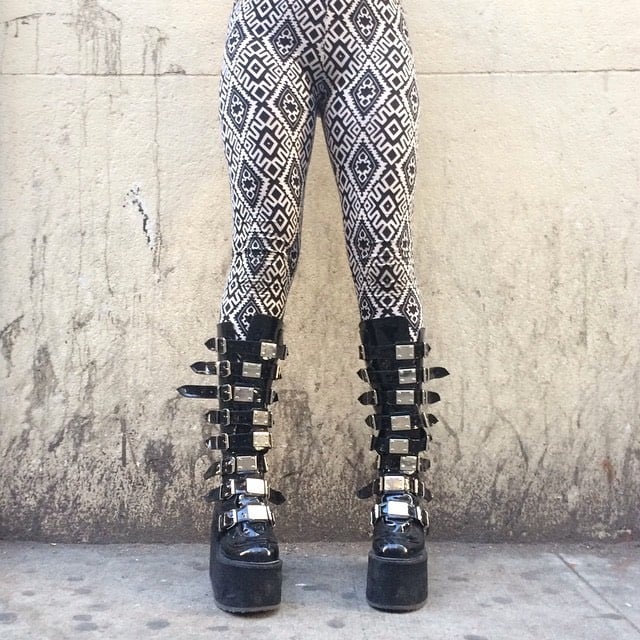
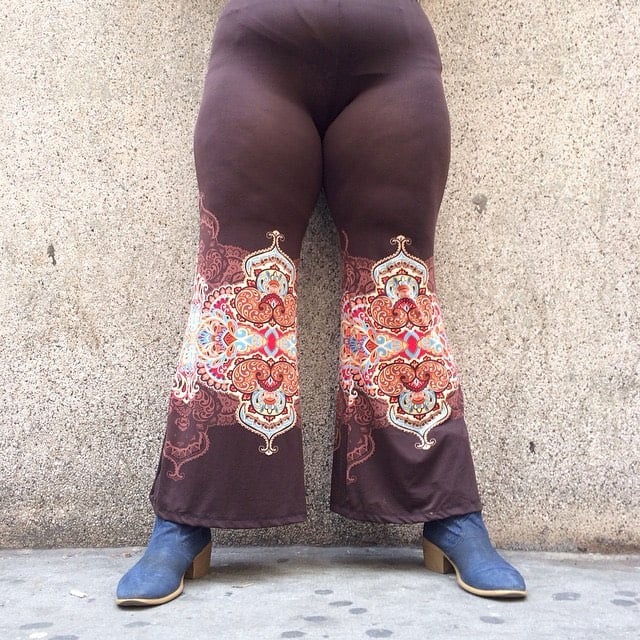
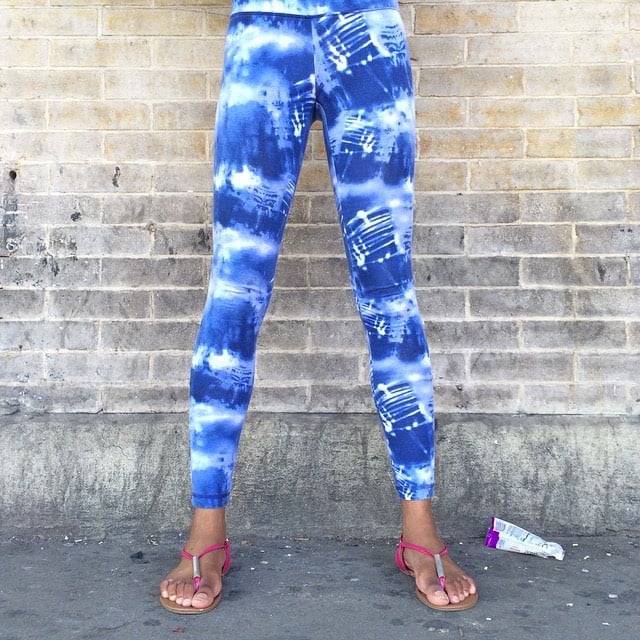
Stacey Baker, who is a photo editor at the NY Times, spends some of her leisure time photographing the legs of women on the streets of NYC. Her Instagram account has 78K+ followers and now she’s turned the project into a book: New York Legs.
Great cover.
Casimir Nozkowski grew up in a building at 70 Hester Street on the Lower East Side of Manhattan. Before his parents occupied it in the late 1960s, the building had been a synagogue, a Prohibition-era distillery, and a raincoat factory. Before they moved out in 2012, Nozkowski “filmed the hell out of it” and made a short documentary about his childhood home.
My documentary is about my childhood home and how much of the past you could still see in it when we left. It’s about the development of a neighborhood a lot of lives have passed through and whether you can protect that legacy while still making room for new lives and new memories. In making my movie, I tried to follow some advice my mom gave me: “Don’t make a movie about moving out. Make it about how great it was to live here.” I like that sentiment but I couldn’t help wondering what was going to happen next to the old building I grew up in.

In 1943, artist and poet Gelett Burgess wrote a poem to New York Mayor Fiorello La Guardia complaining of the poor typography on some of the city’s street signs. La Guardia wrote back, also in verse. (via @john_overholt)
Stay Connected